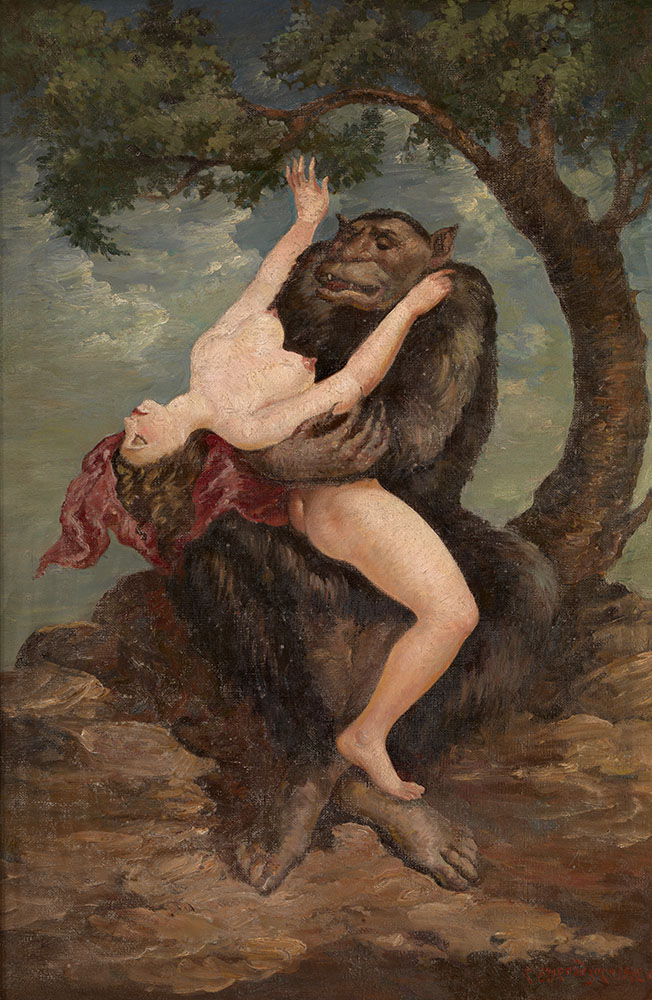MacDougall Auctions 2-3 December 2009
2 December 2009

* 236. GUDIASHVILI, LADO 1896-1980
Devi Abducting a Beauty signed in Georgian and dated 1942
Oil on canvas, 100 by 67.5 cm.
100,000-150,000 pounds
Authenticity certificate from the House Museum of Lado Gudiashvili, Batumi, Georgia, expert Zaur Tsuladze.
Fantasies featuring naked female figures first appeared in Gudiashvili’s work during his years in Paris, where between 1919 and 1925 he honed his skills. This was a time of vigorous growth of modernist trends, and Gudiashvili had a natural inclination towards the decorative and expressive qualities of art of the new age.
Following his return to Georgia, the artist strove for some time to become part of the development of Soviet art, giving his decorative talents entirely over to portraying the “New Life” he could see around him. However, from as early as the second half of the 1930s, fantasy and romanticism were taking precedence over “real”, social themes. Inspired by the success of archaeologists who had discovered major sites in the Armazi district in Mtskheta, the ancient capital of Georgia, Gudiashvili immersed himself in the world of his country’s legendary past, and in 1940 painted The Walk of Seraphita, one of his largest works. The name of Seraphita, the daughter of Zevakh, the junior Pitiakhsh (governor) of Tsar Farsman, became famous from an inscription that had been discovered on one of the tombs. And although there was no hint of any specific historical details in the artist’s work, this theme provided great scope for fantasy, and the successes of Soviet science, which was still in its infancy, served as the necessary source of inspiration. Henceforth, Gudiashvili would turn repeatedly to images inspired by the historical past and Georgian folklore, and in fact began to create, year after year, his own mythology based on Georgian themes.
During the course of each decade the artist painted an entire series of canvases which represented variations on the theme which was close to his heart from the 1920s onwards, that of “maidens and beasts”. Most notably there is an entire gallery of “devis” – perennial characters of national Georgian folk-tales, good or evil spirits, presented in various guises in the works Devi Abducting a Beauty, Before the Stroll, and The Battle of the Amazonians and the Devi (all painted in 1942), Face to Face (1951), Woman with a Lion (1953) etc.
Gudiashvili’s bestiary became more defined and, one might say, more aggressive in its symbolism. In place of the former peaceful idyllic scenes, we are now presented with tempestuous movement: here we have women lost in a dance, rearing horses, masks from national theatrical shows, and magnificent folk-tale garments. In place of the former languorous long figures and faces of whirling maidens, we see the substantial forms of full-blooded lovelies glowing with health. The spiritual aspect recedes into the background, giving precedence to physical beauty, sensuality and the overflowing joy of being alive. Gudiashvili’s style itself and the colours employed by him have also undergone significant changes, one of them being the emergence of thickly applied paint, iridescent colours and a “vibrating” surface, which replaced his former “flat” style.
The artist himself acknowledged that these fantastic images brought him closer to the history and traditions of his homeland: “I have thought about this so much that I have at times mentally reconciled the forces of good and evil. This is how, for example, I thought of my large canvas The Wedding of the Devis (The Wedding Procession of the Devis, 1954). In this work the gigantic, bizarre Devis have been presented by me as good creatures. Our national creativity embodies an inexhaustible source of fantasy, and this world never ceases to inspire me. Through my portrayal of Devis, I have first and foremost wished to express the desire for our motherland to be without enemies and for these inimical elements to develop a respectful and caring attitude towards the motherland. They ought to love and value its beauty … they ought to examine their consciences and become forces for good, and they ought to strive not to slight our country even through mere clumsiness. The portrayal of the Devis shows them to be full of good and love for people, and they even befriend people. This, of course, is possibly mere fantasy and is not entirely justified – is even unacceptable and unfeasible – but this is a world of fairy tales and I love it ... women are in fact protagonists in almost all my works, for after all woman is the source of life and goodness, and therefore women have also occupied the loftiest position in painting as a whole. For me women are the crowning glory of nature and the personification of its inexhaustible abundance”.
Notes on symbols:
* Indicates 5% Import Duty Charge applies.
Ω Indicates 20% Import Duty Charge applies.
§ Indicates Artist's Resale Right applies.
† Indicates Standard VAT scheme applies, and the rate of 20% VAT will be charged on both hammer price and premium.